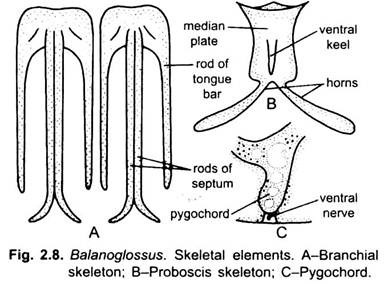In Balanoglossus, there is no definite endoskeleton but there are four structures of a supporting nature, they are a buccal diverticulum, proboscis skeleton, branchial skeleton, and a pygochord.
1. Buccal Diverticulum:
Buccal diverticulum is a hollow pre-oral outgrowth, extending from the roof of the buccal cavity into the proboscis. It was for a long time also called a notochord or a stomochord on the assumption that it represents the anterior portion of the notochord of chordates.
The buccal diverticulum extends forward in some enteropneusts as a slender vermiform process or appendix. The buccal diverticulum is neither analogous nor homologous with the chordate notochord; histologically it is identical with the wall of the buccal cavity, it is apparently nothing more than a pre-oral extension of the gut.
2. Proboscis Skeleton:
Proboscis skeleton or nuchal skeleton is formed by the basement membrane becoming thick to form a laminated plate from which arise two thin horns or cornua, the plate usually has a midventral keel. The proboscis skeleton lies in the proboscis stalk, while its horns extend into the roof of the buccal cavity.
3. Branchial Skeleton:
The walls of the U-shaped gill-clefts are supported by skeletal rods called primary and secondary gill-rods formed by thickening of the basement membrane.
ADVERTISEMENTS:
4. Pygochord:
Pygochord is longitudinal rod-like structure extending from the ventral side of the intestine to the body wall, its function is not known but it may support the soft abdominal region.
